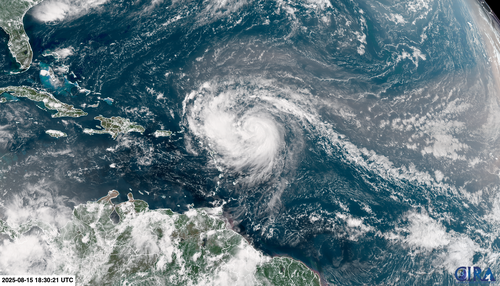It is now a rare Category 5, churning through the Atlantic Ocean north of the Caribbean.
Erin went from a Category 1 hurricane with 120km/h winds at 11am local time Friday to a Category 5 with near 257km/h winds just over 24 hours later.

This puts Erin in the history books as one of the fastest-strengthening Atlantic hurricanes on record, and potentially the fastest intensification rate for any storm earlier than September 1.
Rapid intensification is when a hurricane gains at least 56km/h of wind speed in at least 24 hours.
Extreme rapid intensification historically tends to happen in September and October.
Even more hurricanes are rapidly intensifying in the Atlantic as the oceans and atmosphere warm in response to fossil fuel pollution and the global warming it causes.
This likely makes Erin another example of the increasing extremes of a warming world.
Furthermore, Hurricane Erin is now one of only 43 Category 5 hurricanes on record in the Atlantic – which makes it rare, though not as rare in the context of recent hurricane seasons – as peak strength is becoming easier for storms to achieve.
It is the 11th Category 5 hurricane recorded in the Atlantic since 2016, an unusually high number.
It’s also unusual to see a Category 5 storm form so early in the season, particularly outside of the Gulf of Mexico.
Mid-August is around the time of peak hurricane activity, but the strongest storms tend to occur later in the season.
The 2025 Atlantic hurricane season is now the fourth straight season to feature a Category 5 storm, with two occurring last year, hurricanes Beryl and Milton.
Hurricane Erin is still expected to avoid a direct hit on any land mass, passing north of Puerto Rico, then curving north-northeast into the open Atlantic between the East Coast and Bermuda next week. As it does so, it is expected to double or even triple in size.

Additional strengthening, powered up by the warmer than normal Atlantic, is expected Saturday afternoon.
Hurricane Hunters from the National Oceanic and Atmospheric Administration will investigate Erin Saturday evening.
Fluctuations in intensity are expected for the rest of the weekend, as Erin brings rain and strong wind gusts to the Caribbean islands south of it.
Erin is expected to remain a Category 5 until Monday, when it will start to slowly weaken.
Erin’s powerful wind field is forecast to at least double or triple in size next week, resulting in rough beach conditions on the East Coast.
The storm is passing just north of the Leeward Islands, the Virgin Islands and Puerto Rico this weekend while making a gradual turn toward the north.
It’s unlikely it will make a direct landfall on any of the northeastern Caribbean islands, though tropical alerts are in place for some of these areas cautioning potential threats.
Erin is forecast to track north over the western Atlantic next week, away from the United States and Bermuda, but that could change if the storm turns more or less sharply than currently forecast.
Even if the forecast remains consistent, Erin could cause issues for both places in the form of rough surf and dangerous rip currents.
In anticipation of the hurricane, the US Coast Guard captain for the port of San Juan has directed that the ports of St. Thomas and St. John in the US Virgin Islands, and six seaports in Puerto Rico be closed to all inbound vessel traffic unless specifically authorised.
Rough seas and rip currents around the islands will continue into early next week. Gusty wind and rain – which could be heavy at times – are also impacting the islands as Erin slides by.
Some spots could record five to 10cm of rain this weekend with localised amounts up to 6 inches possible in the heaviest downpours. Intense rain could also cause flash flooding or mudslides.
There’s plenty of fuel in the region for Erin to tap into as sea surface temperatures are much warmer than normal.

They aren’t quite as warm as the record levels reached in 2023 and 2024, but are still far warmer than they’d be in a world that wasn’t heating up.
Erin is the Atlantic’s first major hurricane of the season. Four other systems roamed the Atlantic basin before Erin – Andrea, Barry, Chantal and Dexter – but none were stronger than a tropical storm.
The first hurricane of the season typically forms around August 11, so Erin was slightly behind schedule, particularly compared to early arrivals in recent seasons.
There had already been three hurricanes – Beryl, Debby and Ernesto – by August 15 last year.
August is when the tropics usually come alive: The busiest stretch of the season typically spans from mid-August to mid-October. Forecasters expect above-average tropical activity this year.






